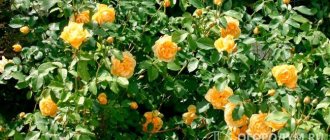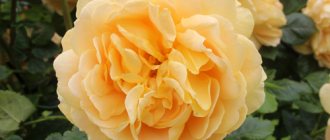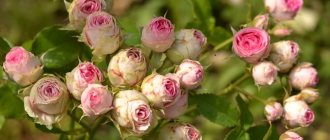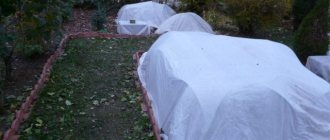Landing rules
Before you begin the planting procedure, you should study the conditions that will be most favorable for the growth and development of English roses bred by David Austin.
Thus, experienced gardeners recommend planting the plant in areas where there is shade. Such conditions are most suitable for roses of this variety. Conversely, direct excessive exposure to sunlight can negatively affect the development of the shrub. It is also important to take into account the fact that almost all subspecies of the plant are tall. That is why they are often used in landscape design for the design of hedges and fences.
Among other things, it is believed that English roses are best grown in groups. Therefore, you should choose several varieties of plants at once and plant them in this combination. Roses of different colors growing next to each other will look especially bright and colorful.
How to grow?
Rose boscobel
First of all, such a plant needs regular feeding. Without this, it will refuse to bloom. In spring, for better growth, nitrogen fertilizers are applied. In summer they are fed with mineral preparations. Before winter, for better cold tolerance, fertilizers should include two elements: phosphorus and potassium.
It is necessary to water at least once a week with warm, settled water. In the absence of rain, 2-2.5 buckets of water are needed per bush. Water the plant at the root, the leaves should remain dry. It is better to do this in the morning and evening, excluding hot times of the day.
The Barok variety is quite resistant to various diseases, however, the following factors may well lead to them:
- improper use of fertilizers;
- unsuitable weather conditions:
- soil acidity and its structure.
If a disease occurs, the affected areas of the rose should be removed if possible. The plant itself and the soil under it should be treated with fungicides. Processing is carried out several times. Loosening is used to saturate the roots with oxygen. It is carried out in spring and autumn. In spring - to protect the roots from drying out, and in autumn - from cold weather.
Trimming
To keep the bush in an attractive form, damaged and dried stems are pruned as follows:
- in spring - basic pruning, in which 2-4 buds are left;
- in summer – weak;
- in the fall - preparation for winter shelter.
Garter
Spreading bushes "Baroque" are used for vertical gardening. This quality is also used in landscape design. Flowers can elevate the most inconspicuous area:
- hide imperfections in a house wall or fence;
- beautifully decorate the columns of a garden gazebo or arch.
When tying up a rose, you must take into account that it will have to be removed for the winter. There are different ways to garter roses:
- you can place it in the shape of a fan against a wall or fence;
- the lashes can be distributed on the grid;
- A rose looks beautiful wrapped around a tree or arch pillar.
When tying a plant to a support, you should follow the following recommendations from experienced gardeners:
- the supports must be strong and reliable so that they can withstand any bad weather;
- make sure that they are in harmony with the design of the site;
- compliance with the length of the shoots is mandatory.
Shelter for the winter
Due to the low flexibility of the branches, it is difficult to cover roses for the winter. This disadvantage is fully compensated by lush and continuous flowering in the summer, giving your site unique beauty and attractiveness.
When covering bushes for the winter, they must be bent to the ground. Spruce branches and other available materials are placed around the rose, on which the lashes removed from the supports are placed. A frame is built above them, which is covered with thick fabric. The structure must match the length of the branches. You can also build a house from wooden panels and cover it.
If the shoots have lost their flexibility, they are left to overwinter in an upright position, wrapped in thick fabric.
In stores you can buy various materials for covering roses.
- Polyethylene film maintains an air layer, which promotes exchange processes in the shelter. In this case, it is necessary to monitor the temperature conditions and air flows inside.
- Non-woven polymer material allows air to pass through, protects from wind, and increases the temperature inside the shelter by several degrees. The material is very durable and can be used for a long time.
Reproduction
Roses, like other plants, can be propagated by cuttings and layering. Not all varieties are suitable for this method, but for Barok it is possible. Rose cuttings are created from its stems. The top of the stem with buds is cut diagonally to a height of 20-30 cm. The cuts are made clear, without torn edges. The stem is cleared of the lower leaves and placed in a vessel with water. If the cuttings have taken root, the buds turn green. The method does not provide a 100% guarantee that the cuttings will take root.
When propagated by layering, a flexible rose shoot is placed in the soil. After rooting, the emerging shoots are separated from the mother bush and replanted. Usually this is done in the spring, and in the fall all that remains is to replant. If propagated by layering in summer or autumn, they are covered for the winter and replanted next year.
The feasibility of pruning
Bushes are pruned for several reasons: to prolong and stimulate flowering, to obtain a beautiful crown and shape of the plant, and also when necessary. It is a well-known fact that inflorescences most often form on last year’s (basal) shoots.
Perform the procedure at the beginning or end of the season. After winter, dry, frozen shoots up to the bud at a height of 40-50 cm from the ground level must be removed. In the fall, before the plant prepares for dormancy, all basal shoots must be cut off at the very root, leaving only fresh young ones, which will bear inflorescences next year.
If climbing roses bloom twice per season, then the bushes should have at least 3 shoots of the current year and approximately the same number of basal branches. If it is difficult for an inexperienced gardener to decide on rose vines, it is recommended to leave 3-4 of the strongest basal shoots, only slightly cutting off their tops.
On grafted bushes, it is imperative to remove shoots from rose hips. This should be done throughout the season, without waiting for spring or autumn.
Diseases, pests and ways to combat them
Rose folklore
This variety is distinguished by strong immunity, which protects flowers from many diseases. What fungal diseases and pests threaten Terracotta:
- rust. Cut off and burn diseased leaves. Treat the bush with Bordeaux mixture (2% solution), a decoction of wormwood or nettle, as well as a solution of soap and copper sulfate;
- gray rot. Remove infected areas. For prevention, feed the rose with manganese fertilizers on rainy days;
- spider mite After removing diseased leaves, treat the bush with any insecticide three times with a break of 5–7 days;
- rose (green) aphid. Treat with soapy water, a decoction of garlic, tobacco or pepper, as well as fufanon, actellik or actara. Several treatments are needed at intervals of three days;
- slobbering pennies. Remove lumps of foam with a damp cloth, spray the bush with water from a hose, then treat with any insecticide;
- leaf roller. A decoction of onion, garlic or tobacco will help against it. The caterpillars will have to be assembled by hand;
- scale insect. Remove parasites with damp cotton wool, treat with fufanon or actara;
- bear Till the soil in early spring and autumn and plant marigolds nearby. On dry days, water the flower with a solution of chicken manure.
For prevention, it is necessary to regularly treat the flower with pest control agents.
For your information! You can plant lavender and marigolds next to the Terracotta rose; their scent repels garden pests.
Lavender or marigold will protect the flower from pests
Beautiful Terracotta needs excellent care. It needs to be watered, fed, weeded, and pruned. With its lush flowering, it will reward the grower a hundredfold.
Rose Terracotta - what kind of variety is it?
Georgia Dadoyan
Terracotta is a rose belonging to the Grandiflora group. To create this group of flowers, breeders crossed Floribunda and hybrid tea varieties. The Terracotta variety has other names: Chocolate Prince, Chocolate Prince, SIMchoca, SIMchoka.
The hybrid tea rose Terracotta is famous for its active flowering, which makes it similar to the floribunda species. But many experts classify these flowers as grandiflora. This flower is also classified as a group of shrubs - semi-climbing shrubs. Rose scrub Terracotta has a developed root system and strong shoots.
What does a Terracotta rose look like?
Rose grandiflora Terracotta appeared in 1994. It was bred by French breeders from (Meilland). Now this flower is extremely in demand in landscape design and floristry.
Petals are brick red, orange, coral, amber or brownish in color
Brief description and characteristics
Terracotta combines the qualities of hybrid tea varieties and floribunda. Its description and characteristics highlight the features of each of these two types.
Note! The Terracotta rose variety is distinguished by very large flowers with a diameter of 12–15 cm. The densely double buds consist of 40–65 petals of a juicy brick-red color. Immediately after the bud opens, its edges become covered with a brown border.
The rose bush blooms very luxuriantly and abundantly. It grows in height up to 70–80 cm. The volume of the bush is approximately 650 cm. Powerful, hard stems firmly hold large flowers, collected in racemose inflorescences. The spines are not very long. The leaves are colored rich green, sometimes with lighter shades. This variety is odorless.
This plant is resistant to many diseases, including fungal infections. The variety has excellent immunity to black spot and powdery mildew. It is quite hardy, frost-resistant, but does not tolerate rain well.
For your information! The terracotta rose got its name from the color of its petals - red with a slight light brown, orange, coral or brick tint.
Large inflorescences
Advantages and disadvantages of the variety
Terracotta has many advantages over other varieties, as well as over many other flowers that are used in landscape design.
Advantages:
- large flower heads;
- abundant and lush flowering;
- stable immunity to most plant diseases.
Experienced gardeners find no drawbacks in this variety.
Use in landscape design
Terracotta is used to make luxurious bouquets. These flowers are actively used in landscape design; they are grown in gardens, flower beds, flower beds and lawns. It is suitable for any landscape style in a variety of compositions. Terracotta beauty will look great with roses of other colors, especially contrasting ones: white, yellow or light pink.
Note! Terracotta park rose will perfectly decorate lawns in gardens, parks and nature reserves. It will give green spaces an exquisite royal look
The petals are pressed tightly together
Advantages and disadvantages of the variety
Rosa Schneewaltzer
Advantages and disadvantages are relative concepts. What is an advantage for one may be a disadvantage for another. The rose has several disadvantages characteristic of English roses, but they are fewer than the advantages.
Teasing Georgia does not get sick and has a number of advantages:
- abundant remontant flowering, good growth and development;
- bright aroma and beautiful dense flowers;
- large size and large number of buds;
- frost resistance;
- decorative leaves that retain their bright green color for a long time.
Compared to other varieties, it shows better resistance to weather conditions and is not afraid of rain.
Rosa Tizing Georgia is not afraid of rain
In addition, it does not rot and does not lose its attractiveness. These characteristics distinguish the plant from varieties whose flowers melt before they have time to open. It compares favorably with, for example, the William Morris variety, which is more susceptible to bad weather and requires several days to resume flowering.
The variety belongs to the landscape variety. Its characteristic drooping flowers on a thin shoot soon lose their petals. They are not suitable for creating bouquets. The culture requires tying to a support. All these characteristics can be perceived as disadvantages and disappoint newbies.
It is popular among experienced flower growers and summer residents. They are happy to grow luxurious bushes, despite the peculiarities of care. This is how, with the light hand of the married couple and thanks to the work of a famous breeder, a rose with the English name Teasing Georgia rose appeared.
0 0 votes
Article rating
Landing Features
The process of planting English roses, to which the plant belongs, is somewhat different from the typical procedure used for most species. The first step is to choose the right place where the culture would feel comfortable.
Selecting a location
On a note! Rosa Tizing Georgia does not give preference to open areas and flower beds that are not protected from the hot rays of the sun. She is more impressed by slightly shaded corners, where the sun shines only for about 5 hours during the day. When choosing a location, you must avoid placing the plant where rain and melt water accumulates.
An unfavorable location would be one in which the wind blows away the snow cover in winter, exposing the seedling to freezing. It is he who acts as a kind of soil insulation during the winter period. The ideal location for planting the English rose Tizin Georgia (the form Tiesing is often used) would be the area next to fences, fences, near the gazebo, veranda and building walls. These objects are used simultaneously as supports for the bush and as protective structures.
Landing
Rosa Georgina needs special attention:
- Before planting it, the roots must be dipped in a solution of a growth stimulator or other substances with a similar effect must be used.
- Then prepare a place in which to make recesses for planting. Their optimal dimensions are 50 cm in depth, width and length.
- A fertile garden soil mixture with the addition of humus is added to the prepared holes.
- Then water is poured into them (1 bucket for each). The planting site is left, and then, after a day, the rose can be planted, straightening the roots and deepening it no more than 10 cm.
First watering
The first abundant watering is carried out over the next day in several stages. The total volume of water per bush for 24-hour hydration is 4.5 buckets. Upon completion, hilling is carried out, which promotes the correct formation of the root system.
Park rose: planting and care in open ground
In order to grow beautiful masterpieces from roses, you must do the following:
Decide on a landing site. This is where to start. This place requires maximum protection from wind and sun. But at the same time there should be no stagnation of liquid or shadow. The depth of groundwater is no more than 1 m below the soil surface. The ideal place for roses to live would be a southern slope, where meltwater flows in the spring.
Prepare the ground. It is recommended to use drained, moderately moist and loose soil. The thickness of the nutrient layer of soil is more than 40 cm. If at least one of the above parameters is not present in the selected area, it is recommended that 14-21 days before planting, you need to mix environmental fertilizers (humus is possible) and loamy soil in a ratio of 50:50.
Prepare seedlings. If the seedlings have an open root system, then first they need to be left in water for 24 hours. Then cut out the leaves and bad root shoots. The above-ground part of the plant must be cut down to 30 cm. The buds under the graft must also be removed. Afterwards, you need to treat the seedling with a three percent solution of iron sulfate, dip the roots in a mixture of clay and mullein (proportion 2:1) - this will be a good protection for the health of the plant.
After all the preparatory procedures have been completed, the roses can be planted. Step by step plan:
- Dig a hole 40 cm in diameter and 70 cm deep.
- Pour drainage into the bottom. This could be: broken brick, pebbles, expanded clay or clay. The thickness of the poured layer should be 7 cm.
- Cover with fertile soil.
- Place the seedling inside the ground.
- Sprinkle regular soil or a special soil mixture on top.
- Trample the ground and water with plenty of water (about 15 liters per bush);
- Cover the seedlings with dry peat in a layer up to 20 cm thick.
Note! Planted bushes should be located 75-90 cm from each other. A distance of up to 1 m can only be in the case of planting standard and climbing roses
Planting a park rose
Looks, thoughts and sounds of voice are powerful tools for winning a man’s heart.
Revealing Taoist secrets, Lisa Piterkina talks in detail about the magic of the gaze - how to make it clear and expressive. If the energies of a man and a woman coincide, then a gentle look will help the development of a love relationship. After all, everyone is great at throwing angry glances, they know how much they can say with their eyes. It's time to take such a powerful energy action responsibly and direct it to obtain personal benefit.
How to use a tea ceremony to make a lasting impression, create a special mood using aromatherapy, conquer your loved one with the sounds of your voice and open the way to hitherto unknown sensations, she tells in her books.
Lisa Piterkina leaves no one indifferent! The reviews she receives are very different, but she receives a huge number of thanks from those who managed to achieve good results, who took courses and listened to her lectures. When getting acquainted with the materials, many questions arise, which she tries to answer in correspondence or at speeches.
Lisa constantly broadcasts new knowledge received from teacher Ji Xiaogang. He speaks Russian perfectly. Thanks to their work, thousands of people have a unique opportunity to receive explanations of Chinese practices.
We can come into contact with strong hitherto unknown sensations and expand the horizons of our consciousness. Lessons continue!
Lisa herself is a beautiful woman, an interesting person and an extraordinary personality, constantly developing spiritually, generously opening the paths to knowledge for her students. The main lesson of Lisa Piterkina is the call to love this world, designed to make us happy.
Use in landscape design
In landscape design, the rose, as a rule, plays a major role. Georgia looks advantageous both in the company of other plants and when planted alone. It looks picturesque on a mowed lawn or as a frame for a park path. The plant serves as a picturesque frame for arches, arbors, and can be the basis of a border or hedge. In a composition with smaller flowers and shrubs, this rose sometimes acts as a background. It is often used to arrange ponds and fountains.
A rose can serve as a picturesque frame for a garden
Important! When designing a personal plot, you need to take into account the nuances of lighting, soil properties, the size of the territory and the interaction of the rose with neighboring plants
Growing a flower
The process of planting English roses in the ground has some differences compared to other plants. For comfortable flower growth, you need to prepare a suitable place for planting and high-quality planting material. They can be seedlings or seeds. The seedlings grow their root system well, take root more easily and are easy to care for. It's more difficult with seeds. Many of them may simply not germinate. Another disadvantage of this method is the loss of the parental characteristics of the species.
Drop off point
Teasing Georgia rose does not like open and brightly lit areas. She prefers shady places with short sunlight.
Important! It is not recommended to plant the plant in places where rain and melt water accumulates. Experienced florists suggest placing roses next to gazebos, house walls and fences
These items will serve as protection and support for the bush.
The right time to plant
Planting in the ground is carried out towards the end of spring. By this time, the earth has time to warm up to 12 °C. Do not delay planting until hot days arrive. Sometimes roses are planted in the fall, until early October. Planting with the onset of cold weather increases the risk that the seedling will not have time to grow roots and will die.
Preparing the soil for planting
The soil for the English rose Georgia Tizing should be fertile, loose, and well-permeable to air. The soil should be slightly acidic or neutral. If there is a large amount of clay, it is diluted with peat and coarse sand. Additives in the form of compost and manure are added to sandy soil. If the acidity is high, it is reduced with wood ash, dolomite flour or chalk.
Disembarkation procedure
Planting the English rose Tizing Georgia requires special attention. Main stages of the procedure:
- Before planting, the roots of the seedling are treated with a root growth stimulator.
- For the plant, holes are formed with a diameter and depth of 50 cm.
- Organic fertilizers are added to the recesses.
- The finished planting site is watered with water (1 bucket per hole) and left for a day.
- After 24 hours, a seedling treated with a growth stimulant is planted to a depth of 10 cm.
- A day later, the bush is watered abundantly and hilled.
After planting, water the plant abundantly
Necessary conditions for growing park roses
To grow park roses, you should choose an area that is well lit, but light shade is also acceptable. The main thing is to avoid drafts. When planted in an area with humus and loose soil, it produces abundant and long-lasting lush flowering. It is optimal to choose loamy soil for planting. If the soil is heavy, rotted compost and sand in equal parts are placed in the planting holes. Add compost with clay to sandy soils. Fertile soil is the key to ensuring that young park rose seedlings take root well.
Adult park roses are watered abundantly in late spring and mid-summer. One bucket per bush once a week will be enough. Usually it is necessary to pour out enough water to wet the soil to a depth of 50 cm. Frequent watering will harm the plant. Lack of moisture, as well as excessive watering, leads to a decrease in the number of buds and the duration of flowering.
Flower propagation
Flower propagation can be done:
- root division;
- cuttings;
- air layering;
- seeds.
You need to decide which one is best to choose on your own. To begin with, it is recommended that you familiarize yourself with each of them in order to understand how much effort you will have to put in, and whether it will be justified.
If we are talking about cuttings, it is recommended to cut them in the spring during formative pruning. Boarding takes place at the same time. However, planting in open ground can only be allowed next spring, since otherwise the plant may not take root.
For your information! Some gardeners think differently: if you plant cuttings in the fall, over the winter a certain type of tissue will form at the cutting sites, which will allow healthy roots to take root in the spring, and the process itself will proceed quite quickly.
Dividing the bush is the most dangerous method for the parent, as it may die. The procedure should be performed with a sharp knife or shovel; it is recommended to disinfect the instruments before performing the procedure. The rhizome should be carefully divided into 2 or several parts, processed at the cut points, and then planted in the proper places.
The seed method is the most time-consuming and also does not guarantee results, and therefore you should choose it only if it is impossible to obtain cuttings. Planting material is sown in moist, loose soil and placed in a greenhouse until sprouts appear. Picking is done when 3-4 petals appear.
Reproduction by air layering is the safest and fastest option. To do this, you need to bend one of the shoots and bend it to the ground. At the point of contact, you should make a small notch, treat it with a means that enhances root growth, cover it with soil and secure it with a staple.
It is important to ensure that the tip of the branch sticks out of the soil. After complete rooting, you can separate both plants
Reproduction by layering
Dividing by cuttings is a fairly inexpensive method. Cuttings are harvested during pruning. It is necessary that each one is about 15 cm long and also has at least 3 buds. The lower end should be treated with a root formation stimulator and placed in a prepared substrate. After the leaves appear and healthy roots form, planting in open ground or an individual pot is permissible.
Miniature roses
These roses were obtained by crossing a dwarf double-flowered variety (Rosa chinensis 'Minima' or 'Roulettii') with hybrid tea roses and Floribunda hybrids. In addition to their miniature size, these plants are resistant to diseases. These roses can only be propagated by cuttings (when propagated by grafting, they lose their miniature size).
To maintain the shape of the plant, stimulate the appearance of new shoots and to prevent insect pests from attacking the roses, it is important to carry out proper pruning.
1.Rose City of York from the group of climbing roses. 2. Chinese rose Minima from the group of miniature roses. 3. Rose Paul's Scarlet from the group of climbing roses.
Features of agricultural technology of the ground cover rose Jazz
One of the main advantages of the Jazz variety is its long flowering period. So, the first flowers appear on the bush in June, and the crop fades in mid-October. However, in order to enjoy the fragrant flowering of the shrub for so long, it is necessary to comply with certain standards of agricultural technology.
How and where to plant
To determine the most suitable landing site, it is important to consider the following rules:
- Groundwater. They must be at a depth of at least 100 cm from the roots of the bush. Otherwise, the root system may simply rot.
- Air circulation. Free air circulation is very important for ground cover roses. It prevents stagnation of liquid in the soil.
Lowlands or swampy areas are absolutely not suitable for planting. Here the plant may rot.
Roses are planted in mid-spring. In autumn, planting should be carried out in a short time, because there is a high risk that the plant will not take root. As for the composition of the soil, you should give preference to loamy or chernozem options - Rose Jazz loves soil with a low level of acidity.
The depth of the planting hole should be about 60 cm and its diameter 70 cm
After the plant is placed in the hole, it is important to carefully straighten the roots. Once planting is complete, the crop is watered with warm water and mulched with a thick layer of peat. It is worth considering that the planting site should not be in the open sun all day long.
The most suitable place is considered to be partial shade. Otherwise, the plant may get sunburned and die.
It is worth considering that the planting site should not be in the open sun all day long. The most suitable place is considered to be partial shade. Otherwise, the plant may get sunburned and die.
Variety Jazz does not like active sunlight
How to care
The basic procedures for caring for the Jazz rose include weekly loosening, watering every 2-3 days and fertilizing. Watering should be done only after the top layer of soil is completely dry. One bush requires about 15 liters of water. It should first be heated in the sun. As autumn approaches, the frequency of watering is gradually reduced, and with the onset of September it stops completely.
Feeding is carried out twice a season. Nitrogen compounds are applied for the first time in early spring to stimulate crop growth. The second feeding is done in the summer, using potash and phosphorus fertilizers. They influence the formation of buds and maintain the plant’s immunity at a high level.
To stimulate budding, it is recommended to remove the first rose flowers. Thus, the next year the bush will be abundantly covered with flowers. Author's advice
In the spring, sanitary pruning should be carried out, during which all damaged, dry shoots will be removed. In the fall, this procedure can be carried out again to thin out the bush a little.
Despite its resistance to cold weather, it is still recommended to cover the plant for the winter. Coniferous spruce branches are used as insulation, which is placed between the branches and on top of the bush. Gardeners who live in regions with cold winters often make special frames. They are covered with plastic bags, which provide reliable protection for the crop from wind and frost.
Watering regimeFeeding with mineral compoundsSpring pruning
Bloom
Rose Princess Anne - description of the variety
Flowering of a crop can be avalanche, repeating and single. Usually the rose blooms profusely, but the formation of buds on old shoots can shorten the lifespan of the flowers.
Periods of rest and activity
Rose Tizing Georgia blooms in early summer and delights with the splendor of color until late autumn. The bushes abound with buds and bloom 3-4 times per season. The dormant period occurs during the winter months, although the leaves may remain green until mid-winter.
How to care during flowering
To help the flower during flowering, it is necessary to tie protruding shoots to a horizontal support. Organic fertilizers are also applied.
If the rose does not bloom, you need to pay attention to the following factors:
- is the landing site chosen correctly?
- age of the plant - if necessary, the rose is rejuvenated by pruning;
- presence of pests and diseases.
Plant care
Despite its rather unique appearance and different planting method, caring for the plant should be the same as for other varieties of roses. This means that you can relieve yourself of the responsibility for learning other rules that would need to be followed when caring for a flower.
Watering rules and humidity
It is recommended to water in the evening strictly at the root of the bush. Despite the fact that the plant can survive rain without causing the flowers to wither, it is still not worth risking them again. English rose does not require high soil moisture, and therefore it is necessary to water the soil to 2 cm, no more.
For your information! Depending on the degree of bushiness of the rose, it may need different amounts of water for watering. Curly ones need to be watered with 15 liters of water, and for bushy ones one bucket is enough.
A dry climate can cause the bush to dry out, but excessive air humidity will not improve its condition. If the rose's root system is constantly waterlogged, this may contribute to the appearance of rot. However, increased air humidity can promote the development of fungus or an influx of insects.
Fertilizing and soil quality
The soil for growing should be light, oxygenated, and rich in nutrients. For active growth and abundant flowering, constant fertilization is required. In the first year after disembarkation, such activities may not be carried out. Starting from the second year, it is worth applying the following types of fertilizing at certain periods:
- during the growing season, the plant needs nitrogen to form stems;
- during the formation of buds and subsequent abundant flowering, nitrogen and phosphorus fertilizers are required;
- To increase frost resistance, it is worth starting fertilizing with potassium at the end of autumn.
It is not recommended to risk the plant by applying fertilizing in the wrong order, as this will confuse the rose; it may begin to lay buds during the dormant period, or begin to grow greenery abundantly during the budding period.
Pruning and replanting
Plant formation is especially important for the plant. Pruning should be done before the onset of frost in autumn and early spring.
Preventive removal of dry and broken shoots will allow the bush to send out fresh shoots more intensively. You can trim the stems as desired:
- severe pruning - shortening shoots by half their length;
- middle pruning - removing only side shoots;
- light pruning - removing a fifth of the stem.
Important! To complete the formation of the bush, feeding is required so as not to drive the plant into stress. It is also necessary to remove faded buds
Bush after pruning
Features of wintering a flower
Before wintering, it is recommended to remove all fallen leaves from under the bush, and also treat the plant with drugs that prevent the occurrence of fungal infection. Not every winter there is a large amount of snow, and therefore it is worth building additional shelter. It is made from spruce spruce branches, which are covered with lutrasil on top.
The branches need to be bent to the ground. If they are not flexible enough, you can carefully dig them up on the side opposite the fold. To prevent the branches from starting to rot, you should place spruce branches under them and secure them with staples in this position.
News
350 rub.
- In stock: 49 pcs.
- Weight: 0 kg.
The delicate colors of this delightful English rose are very beautiful. The flowers are creamy white at the edges and golden yellow in the center, with tones of honey, cream and lemon. They are densely double, cup-shaped, lodged, and sometimes bend under their own weight. They usually appear singly, but sometimes in small clusters, and are always incredibly elegant. The bush is spreading and needs pruning to maintain a beautiful shape. In hot climates, a popular variety for obelisks, reaching 2 m in height. The foliage is shiny, there are few thorns. The aroma is very strong, sweet, fruity. The flowers are a beautiful soft yellow color and do not fade. They are shaped like perfect slightly cupped rosettes. The foliage is pale green. It smells like tea roses, won a prize for fragrance in 2000 and many other awards. “A very exquisite yellow rose of extraordinary beauty and value - an excellent example of the Leander group at its best” - this is how the breeder himself praised this variety
Teasing Georgia can really become that accent in the garden that you notice from afar. This rose is responsive to care - allocate enough space for it in your garden, organize supporting supports and timely watering with fertilizing and you will get the “queen” of your garden
Exquisitely arranged, densely double flowers are cup-shaped. Their slightly faded to light yellow outer petals surround a rich golden yellow center. In cool weather, the yellow tone may change to peach. In the medium-intensive but pronounced aroma, in addition to the main aroma of tea roses, you can feel notes of honey and cream. It was for this fragrance that in 2000 Teasing Georgia was awarded the RNRS Edland Fragrance Medal at a national exhibition in the UK. With good care, Tising Georgia is characterized by extremely abundant flowering, singly or in small clusters on elongated, fairly strong peduncles. To achieve maximum effect, it is recommended to support this variety as a small climbing rose, which in this form can form an attractive bush up to two meters high and about one wide. The light green foliage of Teasing Georgia perfectly complements the delicate yellow blooms. The variety is perfectly resistant to rain and endures even prolonged bad weather, only bowing under the weight of rainwater. But as soon as the weather changes, the flowers, warmed by the rays of the sun, again delight their admirers. Teasing Georgia is named after Georgia Tornow, a German journalist. For his wife Georgia Thornow's 50th birthday, her husband, TV presenter and journalist Ulrich Mayer, wanted to give her something special, exclusive and outrageously expensive. The idea to name the rose after my wife came while she was caring for roses on the terrace. It was not possible to “agree” with the German breeders, and then Ulrich Mayer made an offer to the most famous English nursery. And the issue was resolved positively. So in 1998, a new rose by David Austin was introduced with the name Teasing Georgia, named after Georgia Thornow. The literal translation of Teasing Georgia is to tease (seduce, amuse) Georgia. Or rather Taunting Georgia.
Growing a flower
Even an inexperienced gardener can grow Terracotta. This flower needs to be planted in open ground and then properly cared for.
To plant Terracotta, you will need seedlings. They can be bought in a store or grown from cuttings taken from an adult bush. You need to choose healthy seedlings with strong and well-developed roots.
Important! This variety does not propagate by seeds. Terracotta should be planted in April or early May.
In regions with a warm southern climate, this flower can be planted in early autumn, but so that it takes root and takes root before the first frost, otherwise the rose will die
Terracotta should be planted in April or early May. In regions with a warm southern climate, this flower can be planted in early autumn, but so that it takes root and takes root before the first frost, otherwise the rose will die.
Selecting a location
Terracotta loves an abundance of light, so you need to choose a well-lit place for it. Nevertheless, it should be slightly shaded so that the bright sun does not burn the leaves during the midday hours and in the afternoon. The place should be well ventilated so that cold, damp air does not stagnate.
For planting you need a well-lit area with light shading.
How to prepare the soil and flower for planting
Roses grow only on light, fertile soils, so the soil must be fertilized before planting. For Terracotta, soil with a low degree of acidity is ideal, for example, a soil type such as light loam. The pH level should be between 5.6 and 6.5. It is advisable to choose a place for planting where groundwater lies at a depth of at least 1 m.
How to prepare the soil:
- Dig a hole 60 cm deep.
- Place drainage at the bottom - crushed stone, expanded clay, small stones, gravel.
- Apply fertilizer. The layer thickness should be at least 10 cm. You can feed the soil with manure or compost.
- Then pour another 10 cm of soil.
- The seedling must be placed in a root growth stimulator solution 24 hours before planting in open ground. It is advisable to use the drug heteroauxin.
Step by step landing procedure
It is necessary to correctly comply with all the requirements for planting a flower. If everything is done correctly, then after some time the gardener will be able to enjoy the beauty of roses.
How to plant Terracotta:
- After the seedling has stood for 1 day in a solution of heteroauxin (a root growth stimulator), you need to carefully examine its root system.
- Damaged, weak and too long roots are cut off with disinfected pruning shears.
- The seedling is placed in a hole, the roots are straightened and covered with earth. The root collar should go underground to a depth of 3 cm.
- A young rose bush is watered generously with warm, settled water.
- The ground near the roots of the bush should be mulched with peat or pine bark.
For irrigation you will need 20 liters of water, water 2 times a week
Useful tips for growing park roses
- If you water rose bushes in small doses, the root system will grow chaotically. The roots will be located near the surface of the earth, which promotes freezing.
- Deep rooting leads to better development of the bush. The life expectancy of the bush and its resistance to negative temperatures directly depend on this.
- At the end of summer, when sufficient rainfall occurs, watering should be reduced. In the fall, stop completely, otherwise the bushes will begin to produce young shoots. She will not have time to get stronger before frost and will die.
- In regions where dry weather prevails, when planting park rose seedlings, hydrogel is added to the planting holes. It helps maintain the optimal amount of moisture.
- Pruning park roses in the first three years is irrational.
- Young shoots are pruned by 5-7 cm at the end of summer. This procedure will help you survive the winter easier; it promotes the formation of stronger growth.
- It is necessary to organize winter shelter for young seedlings. They should be spudded and wrapped in non-woven material in 2-3 layers. This will help protect the bushes from bright winter light, strong winds and temperature changes.
- Mature park rose bushes that cannot boast of frost resistance should be spudded and covered with film in late autumn. The optimal temperature for shelter is +5 degrees.
For novice gardeners, park roses may seem difficult to grow. In fact, this is not true. It is not difficult to grow beautiful park roses, planting and caring for which does not require much effort. With proper care, fertilizing, and proper watering, the park rose will delight you with an abundance of charming fragrant flowers for 25 years.
Is it true that you need to be beautiful to win a man's heart?
Men, on a subconscious level, perfectly sense the energy potential that a woman possesses; they will always prefer a chosen one with strong, pure and kind currents, even if she has an ordinary appearance and is older than her chosen one.
Yes, a stunning appearance helps to make a first impression and attract, but how often do we hear regrets that he chose not me, a beauty, but some gray mouse. The inner world of a woman is a real treasure.
Everyone will find something new for themselves in the books. The main thing is that this is not populist information, it carries secret knowledge from time immemorial.
Rose Swany (Swani, Svani, MEIburenac) - what kind of variety is it
The culture was bred from the Japanese wrinkled rose.
The plant has excellent decorative properties
The first varietal rose was produced in 1977 in France.
- In 2003, Meilland breeders developed a new variety of the variety - Pink Swany. This culture is characterized by a change in the color of the inflorescences from pale pink to lilac. They have a pronounced pleasant aroma and look very impressive.
- Then another edition of the ground cover rose Swaney was obtained - Ed. Bright red inflorescences have become a characteristic feature of the culture.
Roses of this variety are characterized by lush, branched bushes with a large number of leaves. They reach 60-70 cm in height and 2 m in diameter. The foliage is small in size and rich green in color.
Terry-type inflorescences reach a diameter of 5-6 cm. The flowers are white in color with a pink tint in the center. They form umbrella inflorescences, each of which can contain up to 20 buds.
Advantages and disadvantages of the variety
The advantages of culture include the following:
- excellent decorative properties;
- long and abundant flowering;
- delicate pleasant aroma;
- frost resistance;
- strong immunity.
At the same time, culture also has some disadvantages.
The plant has many advantages
Despite its resistance to frost, the Swaney rose still needs to be prepared for winter. It also requires quality care.
Use in landscape design
Ground cover rose Swany looks great in flowerpots and containers. It can also be planted on slopes. Thanks to this, it is possible to compact the top layer of soil and protect it from erosion.
The plant is excellent for single plantings and forming spectacular compositions. To emphasize the decorative nature of the crop, you can use dark green bushes.
Important! The rose can be planted with lilacs, viburnum or junipers. They will help to emphasize the attractive flowering of the crop
Description of the variety Teasing Georgia
Roses need space to grow freely. With a bush height that ranges from 1 to 2 m, it is quite spreading and grows up to 1 m wide. It is a climbing plant, so for its normal development it is better to build a support or trellis.
Flowering is long-lasting, of a remontant type, characterized by clearly defined waves. The first flowers are large, then their size gradually decreases. In between flowering periods, single flowers are formed. On intensively growing shoots, many buds are formed in the shape of a bowl or vase, reaching a diameter of 8 to 10 cm.
Their beauty is emphasized by glossy light green leaves that retain their rich color until February. There are not very many thorns on the stems. The culture is not afraid of the influence of atmospheric phenomena and is resistant to bad weather. The flower does not lose its decorative effect, does not rot and does not lose its appearance after rain. The bush is also resistant to low temperatures, showing a level of frost resistance above average.
Description of the variety
What can you lease?
The subject of the contract must necessarily be non-consumable things - that is, property that can wear out, but can still be used for its intended purpose. Therefore, you cannot take, for example, building materials, food, or raw materials for temporary use. In addition, the Civil Code prohibits leasing land plots, reservoirs, forests and other natural objects. It is also impossible to rent military vehicles and equipment without serial numbers for such a long-term lease. Here's what is most often leased:
- Cars and special equipment.
- Equipment - ranging from expensive machines to office equipment.
- Real estate, including residential.
Leasing is often used by entrepreneurs who need expensive equipment, transport, special equipment or industrial real estate.
Poetry of Lisa Piterkina
Having revealed her poetic talents to the world, Lisa Piterkina, whose poems made her notorious, became a successor to the traditions of the Russian poets Barkov and the banned Pushkin.
Of course, if the works were poorly written, then they wouldn’t even talk about them, but the ease of style and beautiful rhymes made them a phenomenon that is still discussed today. A series of shocking hooligan poems, written in 2008, shocked the public with profanity.
Lisa Piterkina has a lot of amazing lyrics about love, about people, but they require concentration, are associated with the experience of deep emotional feelings, and therefore they talk less about them.
Peculiarities
There are a huge number of varieties of English garden roses, most of them belonging to the Shrubs class. The main distinguishing feature of this class is the use of plants belonging to it not only for vertical or not only for horizontal gardening, but also for both types together.
In general, the varieties are not completely identical and have a large number of differences among themselves. For example, some types of English park roses are resistant to external negative effects of diseases and pests. Other varieties easily tolerate a lack of light. Shrubs also differ in their external characteristics: the group includes low, medium, tall, climbing, prostrate, dense and sparse plants.
Despite all of the above, experienced and professional gardeners also identify a number of disadvantages inherent in English roses. Let's take a closer look at these negative characteristics.
- In case of prolonged unfavorable conditions, for example, when there is heavy rain, rose flowers may simply not open. First of all, this applies to roses with cup-shaped and spherical buds.
- New young branches of an English park rose bush can bend greatly (and, as a result, break) under the heavy weight of the blossoming buds. However, do not be scared or upset - usually over time, when the bush takes root and becomes more mature, this problem is solved - the branches become denser and stop bending.
- Some of the varieties are not able to bloom again.
- Despite the fact that from a botanical point of view, David Austin roses are resistant to pests and diseases, in practice this is not always proven.
Description of the English park rose
English park roses come in bushy and climbing varieties.
- The name of the group is English park rose (Austin rose)
- The varieties were bred by an English breeder in the 80s of the last century by crossing Damask and Bourbon roses with hybrid tea varieties of roses and floribunda roses.
- A special feature of this group is the presence of a large number of petals (up to 100 pieces) and a huge variety of aromas, as well as the ability to change the shape of the bush depending on environmental conditions.
- Roses grow well in both sun and partial shade.
- Plants have average resistance to diseases and pests.
- Winter hardiness is average; roses require good shelter.
- It is advisable to build supports, since the shoots can lie down under the weight of the flowers.











